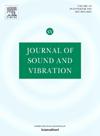具有时变控制参数的动力系统中的引力盆地:芦苇乐器简单模型的攻击瞬态情况
IF 4.3
2区 工程技术
Q1 ACOUSTICS
引用次数: 0
摘要
多稳定性是动力系统中的一种普遍现象,特别是在乐器中,它对应于一组给定参数的几个稳定状态的共存。当一个系统是多稳态时,观察到的状态取决于状态变量的初始条件,因此与引力盆地有关。这里我们考虑一个芦苇乐器的简单模型。分岔分析表明,该系统在吹风压力范围内是双稳态的,吹风压力是音乐家的主要控制参数之一。在双稳定区,计算了控制参数恒定的经典情况下的吸引盆地边界和吹压饱和斜坡的边界。这些吹奏压力的轮廓被选为所谓的吹奏压力的攻击瞬态的原型表示,在此期间,音乐家开始在乐器中吹奏以从沉默中创造音符。众所周知,攻击瞬态在音乐环境中是至关重要的,但在乐器系统的物理模型中却常常被忽视。将时域模拟与基于支持向量机的机器学习技术相结合,对盆地间的引力分离矩阵进行了数值计算。我们的研究结果表明,吹风压力的攻击瞬态显著影响了不同稳定状态的实际可观测性,这表明它们可能被音乐家用来在盆地之间导航。从更普遍的角度来看,这些结果与速率引起的倾斜现象有关,因此可能超出乐器的特殊情况。本文章由计算机程序翻译,如有差异,请以英文原文为准。
Basins of attraction in a dynamical system with a time-varying control parameter: The case of attack transients in a simple model of reed musical instrument
Multistability, a common phenomenon in dynamical systems in general and in musical instruments in particular, corresponds to the coexistence of several stable regimes for a given set of parameters. When a system is multistable, which regime is observed depends on the initial conditions on the state variables, and therefore relates to the basins of attraction. Here we consider a simple model of reed musical instrument. A bifurcation analysis shows that the system is bistable on a range of the blowing pressure, which is one of the main control parameters for the musician. In the bistability region, the boundary between basins of attraction is computed for the classical case of constant control parameters in the one hand, and for saturating ramps of the blowing pressure on the other hand. These profiles of the blowing pressure are chosen as prototypical representations of the so-called attack transients of the blowing pressure, during which the musician starts to blow in the instrument to create a musical note from silence. Attack transients are known to be of crucial importance in a musical context, yet mostly overlooked in physical models of the musician–instrument system. The separatrix between basins of attraction is computed numerically by combining time-domain simulations with a machine learning technique relying on support vector machine. Our results demonstrate that attack transients of the blowing pressure significantly affect the practical observability of the different stable regimes, suggesting that they might be used by musicians to navigate between basins. From a more general point of view, these results relate to rate-induced tipping phenomena and might therefore be of interest beyond the particular case of musical instruments.
求助全文
通过发布文献求助,成功后即可免费获取论文全文。
去求助
来源期刊

Journal of Sound and Vibration
工程技术-工程:机械
CiteScore
9.10
自引率
10.60%
发文量
551
审稿时长
69 days
期刊介绍:
The Journal of Sound and Vibration (JSV) is an independent journal devoted to the prompt publication of original papers, both theoretical and experimental, that provide new information on any aspect of sound or vibration. There is an emphasis on fundamental work that has potential for practical application.
JSV was founded and operates on the premise that the subject of sound and vibration requires a journal that publishes papers of a high technical standard across the various subdisciplines, thus facilitating awareness of techniques and discoveries in one area that may be applicable in others.
 求助内容:
求助内容: 应助结果提醒方式:
应助结果提醒方式:


